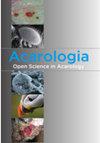A new species of Neoseiulus Hughes (Acari: Phytoseiidae) from Karnataka, India with an identification key to Indian species of the genus
IF 0.9
3区 农林科学
Q3 ENTOMOLOGY
引用次数: 0
Abstract
Neoseiulus ramabettaensis n. sp. Döker and Jose is described based on specimens collected from Karnataka, India. The new species is accommodated to the cucumeris species group and ceratoni species subgroup in the genus Neoseiulus Hughes (Acari: Phytoseiidae). The morphological characters including conspicuously longer setae j1 and j3, in addition to Z4 and Z5, chelicera dentition, wider ventrianal shield at anterior corners, large crescentic preanal pores, absence of macroseta on legs II-IV, and presence of macroseta on genu I distinguished the new species from its congeners in the ceratoni species subgroup. The current study describes a macroseta on leg I (SgeI) for a species listed in the ceratoni species subgroup for the first time. Indeed, the presence of SgeI, and the absence of macroseta on leg IV are unusual characters for the genus Neoseiulus, except SgeI present in a few species in Neoseiulus desertus species group. Therefore, chaetotaxy of legs frequently used in the systematics of other groups of Mesostigmata which are closely related to the phytoseiid mites, seems to be an important morphological character and should be included in future descriptions. In addition, we constructed an identification key for the Indian species of the genus.印度卡纳塔克邦Neoseulus Hughes一新种(Acari:Phytoseidae)及其印度种的鉴定关键
根据从印度卡纳塔克邦采集的标本,描述了拉马贝塔新虫(Neoseulus ramabettaensis n.sp.Döker and Jose)。该新种隶属于新叶螨属(Acari:Phytoseidae)的cucumeris种群和角龙属(ceratoni)亚群。除Z4和Z5外,其形态特征包括明显较长的刚毛j1和j3、螯齿列、前角较宽的腹侧盾、较大的新月形肛门前孔、II-IV腿上没有巨大目和I属上有巨大目,这些特征将该新种与其在角龙属亚群中的同类区分开来。目前的研究首次描述了一个被列入角龙属物种亚组的物种的腿I上的巨大目(SgeI)。事实上,除了SgeI存在于Neoseulus desertus物种群中的少数物种中之外,SgeI的存在和腿IV上的macroseta的缺失是Neoseulus属的不寻常特征。因此,在与植物寄生螨密切相关的中斯的目其他类群的系统学中经常使用的腿毛状体似乎是一个重要的形态学特征,应纳入未来的描述中。此外,我们构建了该属印度物种的识别密钥。
本文章由计算机程序翻译,如有差异,请以英文原文为准。
求助全文
约1分钟内获得全文
求助全文
来源期刊

Acarologia
ENTOMOLOGY-
CiteScore
2.00
自引率
18.20%
发文量
81
期刊介绍:
Acarologia is a free open-access journal. Please help us by submitting manuscripts in accordance with following instructions.
All manuscripts which do not conform to the instructions will be returned to authors without the benefit of review.
Acarologia publishes the results of original research on all aspects of Acarology.
The journal policy is that taxonomic descriptions should include several species within a same genus/family, when possible.
The editors reserve the right to refuse manuscripts when authors intentionally divide individual species descriptions of the same genus/family into distinct publications.
Single species descriptions should be clearly justified based on their scientific interest.
 求助内容:
求助内容: 应助结果提醒方式:
应助结果提醒方式:


